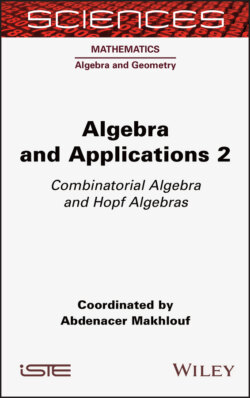Читать книгу Algebra and Applications 2 - Группа авторов - Страница 21
1.3.3. Connected filtered bialgebras
ОглавлениеA filtered bialgebra on k is a k-vector space together with an increasing ℕ-indexed filtration:
endowed with a product m : ℋ ⊗ ℋ → ℋ, a coproduct Δ : ℋ → ℋ ⊗ ℋ, a unit u : k → ℋ, a counit ε : ℋ → k and an antipode S : ℋ → ℋ, fulfilling the usual axioms of a bialgebra, and such that:
[1.11]
[1.12]
It is easy (and left to the reader) to show that the unit u and the counit ε are of degree zero, if we consider the filtration on the base field k given by k0 = {0} and kn = k for any n ≥ 1. Namely, u(kn) ⊂ ℋn and ε(ℋn) ⊂ kn for any n ≥ 0.
If we ask for the existence of an antipode S, we get the definition of a filtered Hopf algebra if the antipode is of degree zero, that is, if:
[1.13]
for any n ⊂ 0. Contrarily to the graded case, it is not likely that a filtered bialgebra with antipode is automatically a filtered Hopf algebra (see, for example, Montgomery (1993, Lemma 5.2.8), Andruskiewitsch and Schneider (2002) and Andruskiewitsch and Cuadra (2013)). The antipode is, however, of degree zero in the connected case: for any x ∈ ℋ, we set
[1.14]
We say that the filtered bialgebra ℋ is connected if ℋ0 is one-dimensional. There is an analogue of Proposition 1.6 in the connected filtered case, the proof of which is very similar:
PROPOSITION 1.7.– For any x ∈ ℋn, n ≥ 1, we can write:
[1.15]
The map is coassociative on Ker ε and sends ℋn into (ℋn-k)⊗k + 1.
As an easy corollary, the degree of the antipode is also zero in the connected case, that is, S(ℋn) ⊆ ℋn for any n. This is an immediate consequence of the recursive formulae [1.19] and [1.20] below.
Any graded bialgebra, or the Hopf algebra, is obviously filtered by the canonical filtration associated with the grading:
[1.16]
and in that case, if x is a homogeneous element, x is of degree n if and only if |x| = n.
